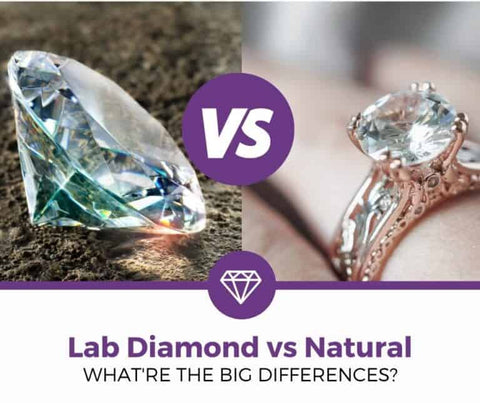Did you know that until 1870, the only places where diamonds were obtained from were the river beds of Brazil and India?
Even though there are more sources of diamonds today, diamonds are still rare and out of reach for many people.

So, where do all the diamonds in engagement rings come from?
Some of them are made in the lab, and others are mined.
Are the diamonds grown in the lab the same as the ones that come from the mines?
Should your engagement ring be made from lab-created or natural diamond?
Are engagement rings made from lab-created diamonds cheaper than the natural ones?
This article answers all these questions and more.
1. What are natural diamonds?
Natural diamonds are precious stones formed 150 to 200 kilometers below the Earth's surface. The stones’ strength results from the conditions under which they have formed: pressure of over 55 kilobars and temperatures between 900 and 1300 degrees Celsius.
To get an idea of the conditions under which natural diamonds are formed, let’s compare the numbers above to more familiar ideas. The atmosphere's pressure is about 1,000 millibars, so natural diamonds are formed at pressures about 50,000 times the atmosphere's pressure. Water boils at around 100 degrees Celsius, meaning that diamonds are formed between 9 and 13 times that temperature. These conditions also have to be sustained over a long time. In this case, a long time means 3 billion years.
Once formed, natural diamonds are pushed closer to the surface of the Earth by volcanic eruptions.
2. How are natural diamonds mined?
Several methods are used to mine diamonds, including:
Open-pit mining: Sometimes called open-cast mining, involves using ore trucks and hydraulic shovels to extract diamonds or diamond-bearing ore from an open-air pit. This method is more suitable where diamonds can be found near the surface.
Hard rock mining: Involves extracting diamonds from diamond-bearing ore. The ore is broken from the rock underground and brought to the surface so that metallurgists can extract diamonds.
Block caving: This is an underground rock mining method where the diamond is extracted by creating an underground tunnel in a section of ore. This can be done by drilling or blasting. The process creates an unsupported roof that will eventually collapse. The ore is then collected and brought above ground for processing.
3. How are natural diamonds processed?
According to one of the largest independent diamond mining companies globally, Petra Diamonds, once the ore is extracted from the ground, diamonds need to be separated from other materials.
The extraction process involves crushing the ore to create a heavy concentrate from which diamonds are removed using an X-ray machine or other methods like the grease table. On the grease table, the diamonds stick to the grease, and unwanted material can run off with the water.
4. What are lab-created diamonds, and how are they made?
Even though lab-created diamonds have been around since the 1950s, they have become more popular among today's engagement ring buyers. The British Broadcasting Corporation suggests that the popularity of lab-created diamonds is driven by “young people [who] are falling out of love with mined diamonds because of their high environmental and humanitarian costs.”

As the name suggests, lab diamonds are created in a laboratory. In other words, we can refer to them as human-made diamonds. Both lab and natural diamonds are created when carbon crystals bond together under high pressure and temperature. Therefore, lab-created and natural diamonds have the same physical properties.
Depending on the production method, lab-created diamonds can be categorized into two groups: diamonds made by chemical vapor deposition (CVD) and diamonds made using the high-pressure, high-temperature system (HPHT).
The HPHT method subjects a small piece of natural diamond to high temperature and pressure. Under the massive pressure and heat, the carbon starts to melt and gather around the small diamond. Careful cooling results in a new bigger diamond.
The CVD method also starts with a small diamond (usually a HIP diamond) exposed to high temperature and pressure inside a sealed chamber. The processes inside the chamber break down the gases, allowing pure carbon to stick to the small diamond seed.
The great news is that lab-grown diamonds don't need 3 billion years to be ready for the market. For small sizes, lab-grown diamonds will be ready in about a month, thanks to the wonders of technology.
5. What are the differences between natural diamonds and lab diamonds?
Even though lab-created and natural diamonds are all authentic diamonds, it's vital to know the difference between the two types. This is because there is usually a difference in price and resale value between the lab-grown and natural diamonds. So, you wouldn't want anyone passing off lab-grown diamonds as natural diamonds.
The main difference between natural diamonds and lab diamonds is that the former are produced naturally in the Earth's bowels, and the latter are made in the laboratory. At a basic level, this is the only difference between the two kinds of diamonds. Even though they are human-made, lab diamonds feel and look like natural diamonds.
An ordinary person will often determine whether the diamonds in front of them are lab-produced or natural by looking at the price. Why would there be a price difference if both types of diamonds are the same? The price difference results from the fact that much more resources are required to get natural diamonds to the market than is the case with getting lab-grown diamonds.
6. What quality factors describe and classify diamonds?
Just because an engagement ring or piece of jewelry contains a diamond does not mean that it has the same value as the next one containing diamond. According to the Gemological Institute of America (GIA), “Diamonds with certain qualities are more rare—and more valuable—than diamonds that lack them.”

The GIA lists some of the factors that determine the quality and value of a diamond:
Color: Colorless diamonds are the hardest to find and are therefore the most expensive.
Clarity: The clearer a diamond is, with fewer "inclusions", the more value it has.
Cut: A well cut diamond will be more valuable than one that is poorly cut or uncut. Expert diamond cutters know how to play around with angles and light to create a dazzling spectacle.
Carat weight: Diamonds are weighed per carat. However, the same number of carats in a large diamond will be more valuable than the same number of carats divided into several smaller diamonds.
7. What are alternatives to diamonds?
There are several alternatives to natural and lab-created diamonds:
Natural moissanite: This is a gemstone made from silicon carbide. Even though natural moissanite looks like a diamond, it has a very different structure compared to the real diamond. It can also be manufactured in the lab.
Cubic zirconia: Can also be made in the lab to look precisely like a diamond. However, it doesn't have the strength of diamond. Over time, it will become prone to scratches and easily breakable. Unlike real diamonds, cubic zirconia will also absorb oils from your body, which could make the gemstone lose its luster over time.
Quartz: This is one of the most common natural materials used to make diamond alternatives. Even though quartz will never look like the best diamond, a great artisan can make a diamond engagement ring with this stone that can look better than one made from low-quality diamond. However, over time, jewelry made from this type of stone will also lose its shine due to scratching.
Several other diamond alternatives like emerald, ruby, aquamarine, white zircon, and white sapphire are available.
8. What are diamond certifications, and why are they important?
Because there are dozens of diamond alternatives, many people who want to invest in a diamond engagement ring can be worried about distinguishing the real from the fake. Even when you buy the real diamonds, how do you know that your money will not end up paying for weapons in a country at war where the diamonds are produced?
Organizations that certify diamonds, such as the American Gem Society (AGS) and the Gemological Institute of America (GIA), give diamond buyers peace of mind by certifying the precious stones. The AGS describes itself as “a nonprofit trade association of fine jewelry professionals dedicated to setting, maintaining and promoting the highest standards of ethical conduct and professional behavior through education, accreditation, recertification of its membership, gemological standards, and gemological research.”
The Cape Town Diamond Museum defines a diamond certificate as “a formal document that contains a detailed description of the specific diamond.” It continues, “The diamond dossier or diamond grading report contains verified information about the diamond's unique characteristics; the cut, carat weight, color, and clarity with a few additional comments in regards to the diamond's symmetry, polish, and fluorescence.” The museum adds that “having a diamond certificate is the best way to prove your unique gemstone’s identity.”
9. Should I buy a lab-grown or naturally mined diamond for an engagement ring?
An engagement ring is a highly personal possession. For this reason, it’s hard to explicitly say whether you should go with the natural or lab-created diamond when buying one. It's important to remember that both lab-grown and natural diamonds are all diamonds.
There are a few factors that can help you make the decision:
Price: Lab-created diamonds are likely to be cheaper than natural diamonds because they come through a shorter supply chain.
Resale value: If you want your diamond engagement ring to maintain a higher resale value, you may want to go with natural diamonds. Lab-created diamonds generally lose value faster than natural ones.
Care for the environment: If you are concerned about the effect of mining on communities and the possibility of buying diamonds coming from conflict zones, you may want to opt for lab-created diamonds.
10. Why is it essential for me to know where my diamonds come from?
When you buy a diamond engagement ring, whether lab-created or natural, it's essential to be clear about the conditions under which the diamonds are mined or made. While lab-created diamonds don't have many issues, mined diamonds can sometimes come from conflict-riddled zones. Therefore, buying such diamonds could mean that you are inadvertently supporting conflict.
Diamonds that are illegally traded to fund conflicts, especially in central and western Africa, are known as conflict or ‘blood’ diamonds. In an article published by CNN, Paul Armstrong quotes the United Nations, which describes conflict diamonds as “diamonds that originate from areas controlled by forces or factions opposed to legitimate and internationally recognized governments, and are used to fund military action in opposition to those governments.”



